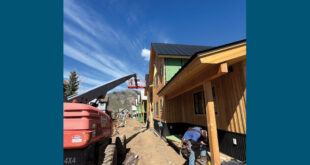Tributaries quickly drying up
By Mark Reaman
Not only is the area under fire restrictions, the water situation is rapidly drying up as well. The two main reservoirs in the county, Blue Mesa and Taylor reservoirs, are significantly below their average fill levels for this time of year and the tributaries that feed them are down to trickles in some cases.
Last winter was very dry with a snowpack totaling just 40 percent of average for the Upper Gunnison Basin, and spring and summer temperatures have been warmer than normal with no significant precipitation seen in months. It all contributes to drought conditions.
Upper Gunnison River Water Conservancy District (UGRWCD) general manager Frank Kugel said that as an example, the Slate River is running at about one-tenth of its average flow for this time of year. “The Slate has dropped dramatically, as have many of the rivers and streams in the Upper Gunnison,” Kugel said. “All the local tributaries are dropping so quickly right now. By all accounts we are not as dry as it was in 2002 but we are approaching that point.”
The Upper Gunnison Taylor River Local Users Group last week decided to not increase the release from the Taylor Reservoir as originally anticipated. The plan was to go from the current release rate of 250 cubic feet per second (cfs) to 300 cfs, but Kugel explained the release rate would stay at 250 for the time being.
The UGRWCD counsel John McClow noted, “The inflows to Taylor Park Reservoir have dropped to 89 cfs, a level we normally see in the fall. At the current release rate, we are losing about 300 acre-feet of storage per day. In my opinion, that is not sustainable, so at this point the release plan is uncertain.”
McClow added, “On the face of it, the reservoir storage doesn’t look too bad; however, they are on the declining side of the curve when they would ordinarily be filling until sometime in late July.”
Blue Mesa is 45 feet below its full point according to Kugel, and is about 58 percent full but that is very unusual for this time of year. Blue Mesa reached its peak storage capacity on June 3, while Taylor peaked on June 9. Both reservoirs would normally hit peak storage in mid to late July.
“The combination of down-river water demands and low inflows is making it a dire situation,” explained Kugel. “Fortunately the Uncompahgre Valley Water User Association has told us they do not anticipate making a call with its Gunnison Tunnel water right on the reservoirs this year like it did in 2002 and 2003. Those calls have a very negative impact on the local ranchers.
“We do anticipate some earlier than normal calls for water on the Slate and possibly the East and Taylor rivers from downstream users with more senior water rights,” Kugel continued. “If that happens some people might have to curtail their water use. If, for example, a subdivision that uses water in the Slate River drainage is under the Upper Gunnison water protection program in Meridian Lake, then they are protected from that call. By all accounts we are not as dry as 2002 but we are approaching that point.”
Senior water rights in Colorado are based on the date they were filed and those with the oldest rights have the first right to use designated water in a certain basin. Thus a 1950 water right can make a “call” on water in the Gunnison basin and use it before a 1980 water right. If there is no water left after the 1950 entity makes a “call,” then the entity with the 1980 water is basically out of luck.
The one bright spot is that there is some rain forecast for the end of next week in mid-July. Kugel said the monsoonal forecast is looking good once that begins as well. “But this next week is supposed to be hot and dry so we continue to be in a tough spot.”
The Taylor River users group will meet on Monday, July 9 to further discuss the water situation.
 The Crested Butte News Serving the Gunnison Valley since 1999
The Crested Butte News Serving the Gunnison Valley since 1999

